Files in this item
Inherited and spatial disadvantages : a longitudinal study of early adult neighbourhood careers of siblings
Item metadata
| dc.contributor.author | Manley, David | |
| dc.contributor.author | van Ham, Maarten | |
| dc.contributor.author | Hedman, Lina | |
| dc.date.accessioned | 2020-05-12T12:30:02Z | |
| dc.date.available | 2020-05-12T12:30:02Z | |
| dc.date.issued | 2020 | |
| dc.identifier | 265420091 | |
| dc.identifier | 59841257-9f98-481f-9180-a92c88b0a435 | |
| dc.identifier | 85084454257 | |
| dc.identifier | 000532477000001 | |
| dc.identifier.citation | Manley , D , van Ham , M & Hedman , L 2020 , ' Inherited and spatial disadvantages : a longitudinal study of early adult neighbourhood careers of siblings ' , Annals of the Association of American Geographers , vol. 110 , no. 6 , pp. 1670-1689 . https://doi.org/10.1080/24694452.2020.1747970 | en |
| dc.identifier.issn | 0004-5608 | |
| dc.identifier.other | ORCID: /0000-0002-2106-0702/work/74117882 | |
| dc.identifier.uri | https://hdl.handle.net/10023/19922 | |
| dc.description | The work presented in this paper was supported by funding from the European Research Council under the European Union’s Seventy Framework Programme (FP/2007–2013)/ERC Grant Agreement n.615159 (ERC Consolidator Grant “DEPRIVEDHOODS, Socio-spatial inequality, deprived neighbourhoods, and neighbourhood effects.)” | en |
| dc.description.abstract | Understanding how inequalities are transmitted through generations and restrict upward spatial mobility has long been a concern of geographic research. Previous research has identified that the neighborhood in which someone grows up is highly predictive of the type of neighborhood he or she will live in as an independent adult. What remains largely unknown is the relative contribution of geography compared to the contribution of the family context in forming these individual life outcomes. The aim of this article is to better understand the role of the spatial–temporal contexts of individuals in shaping later life outcomes, by distinguishing between inherited disadvantage (socioeconomic position) and spatial disadvantage (the environmental context in which children grow up). We use a sibling design to analyze the neighborhood careers of adults after they have left the parental home, separating out the roles of the family from that of the neighborhood in determining residential careers. We employ rich Swedish Register data to construct a quasi-experimental family design to analyze residential outcomes for sibling pairs and contrast real siblings against a control group of “contextual siblings.” We find that real siblings live more similar lives in terms of neighborhood experiences during their independent residential careers than contextual sibling pairs but that this difference decreases over time. The results show the importance of geography, revealing long-lasting stickiness of spatial–temporal contexts of childhood. | |
| dc.format.extent | 20 | |
| dc.format.extent | 2235776 | |
| dc.language.iso | eng | |
| dc.relation.ispartof | Annals of the Association of American Geographers | en |
| dc.subject | Hybrid model | en |
| dc.subject | Intergenerational transmission | en |
| dc.subject | Residential selection | en |
| dc.subject | Siblings | en |
| dc.subject | G Geography (General) | en |
| dc.subject | HM Sociology | en |
| dc.subject | 3rd-DAS | en |
| dc.subject | BDC | en |
| dc.subject | R2C | en |
| dc.subject.lcc | G1 | en |
| dc.subject.lcc | HM | en |
| dc.title | Inherited and spatial disadvantages : a longitudinal study of early adult neighbourhood careers of siblings | en |
| dc.type | Journal article | en |
| dc.contributor.sponsor | European Research Council | en |
| dc.contributor.institution | University of St Andrews. School of Geography & Sustainable Development | en |
| dc.identifier.doi | 10.1080/24694452.2020.1747970 | |
| dc.description.status | Peer reviewed | en |
| dc.identifier.grantnumber | ERC-2013-CoG | en |
This item appears in the following Collection(s)
Items in the St Andrews Research Repository are protected by copyright, with all rights reserved, unless otherwise indicated.

